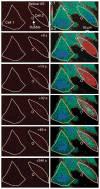Ultrasound-mediated drug delivery for cardiovascular disease
- PMID: 23448121
- PMCID: PMC4026001
- DOI: 10.1517/17425247.2013.772578
Ultrasound-mediated drug delivery for cardiovascular disease
Abstract
Introduction: Ultrasound (US) has been developed as both a valuable diagnostic tool and a potent promoter of beneficial tissue bioeffects for the treatment of cardiovascular disease. These effects can be mediated by mechanical oscillations of circulating microbubbles, or US contrast agents, which may also encapsulate and shield a therapeutic agent in the bloodstream. Oscillating microbubbles can create stresses directly on nearby tissue or induce fluid effects that effect drug penetration into vascular tissue, lyse thrombi or direct drugs to optimal locations for delivery.
Areas covered: The present review summarizes investigations that have provided evidence for US-mediated drug delivery as a potent method to deliver therapeutics to diseased tissue for cardiovascular treatment. In particular, the focus will be on investigations of specific aspects relating to US-mediated drug delivery, such as delivery vehicles, drug transport routes, biochemical mechanisms and molecular targeting strategies.
Expert opinion: These investigations have spurred continued research into alternative therapeutic applications, such as bioactive gas delivery and new US technologies. Successful implementation of US-mediated drug delivery has the potential to change the way many drugs are administered systemically, resulting in more effective and economical therapeutics, and less-invasive treatments.
Conflict of interest statement
Grant funding from NIH R01 NS047603; NIH R01 HL059586; NIH R01 HL74002; NIH F32 HL104916 supported the coauthors during the preparation of this manuscript.
Figures





References
-
- Komarova Y, Malik A. Regulation of endothelial permeability via paracellular and transcellular transport pathways. Annu Rev Physiol. 2010;72(1):463–93. - PubMed
-
- Zaragoza C, Márquez S, Saura M. Endothelial mechanosensors of shear stress as regulators of atherogenesis. Curr Opin Lipidol. 2012;23(5):446–52. - PubMed
-
- Binsalamah Z, Paul A, Prakash S, Shum-Tim D. Nanomedicine in cardiovascular therapy: recent advancements. Expert Rev Cardiovasc Ther. 2012;10(6):805–15. - PubMed
-
- Stancu C, Toma L, Sima A. Dual role of lipoproteins in endothelial cell dysfunction in atherosclerosis. Cell Tissue Res. 2012;349(2):433–46. - PubMed
Publication types
MeSH terms
Substances
Grants and funding
LinkOut - more resources
Full Text Sources
Other Literature Sources
Medical
